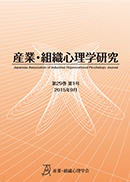All issues

Volume 29 (2015 - 201・・・
- Issue 2 Pages 59-
- Issue 1 Pages 3-
Volume 29, Issue 1
Displaying 1-4 of 4 articles from this issue
- |<
- <
- 1
- >
- >|
-
Mina NAKANO2015Volume 29Issue 1 Pages 3-14
Published: 2015
Released on J-STAGE: August 05, 2019
JOURNAL FREE ACCESSThe purpose of this study was to investigate interventions provided by psychotherapists for “newtype depression” in industrial fields. Interviews were conducted with eight psychotherapists whose clients had “new-type depression” in order to examine their experiences and emotional changes, as well as to ask what they would do as a psychotherapist for a hypothetical case of “new-type depression”. The data obtained were then analyzed using the GTA method. The results showed that many psychotherapists believed that support for dealing with real-life issues in the workplace is the most desirable option in terms of effectiveness and should be given first priority during “new-type depression” treatment. The findings also suggest that helping the clients to understand themselves is also effective for new-type depression treatment and recommended when the situation allows.View full abstractDownload PDF (1205K) -
Hiroko FUKUO, Atsuko KANAI2015Volume 29Issue 1 Pages 15-28
Published: 2015
Released on J-STAGE: August 05, 2019
JOURNAL FREE ACCESSThe purpose of this study is to examine how human errors which cause labor accidents occur and how they can be reduced to a minimum. In this study, two labor accidents caused by human errors were dealt with as case studies, in which we conducted semi-structured interviews with sixteen employees of a manufacturing company including victims, coworkers, maintenance workers, supervisors and managers. This study clearly states problems of the organization: maintenance delay of unstable facilities, managers’ ignorance of employees’ requests, attachment of importance to productivity, difficulty of evaluation of safety activities, and management of production line in a haphazard way. The result indicates what top executives, managers and supervisors should do to prevent human errors.View full abstractDownload PDF (1135K) -
Kengo Nawata, Hiroyuki Yamaguchi, Toru Hatano, Mika Aoshima2015Volume 29Issue 1 Pages 29-43
Published: 2015
Released on J-STAGE: August 05, 2019
JOURNAL FREE ACCESSThis study investigated the relationship between team composition based on work orientation and team performance. By examining the correlation between team performance and the maximum and minimum scores for work orientation, we determined whether the score of member with the highest work orientation correlated with team performance and whether the score of those with the lowest correlated with team performance. A survey of 161 teams comprising 1400 members from five different companies was conducted. The survey results show that the minimum score significantly correlated with team performance and team processes; however, the maximum score did not. This result suggests that a team member with negative work orientation worsens the overall team performance.View full abstractDownload PDF (1135K) -
2015Volume 29Issue 1 Pages 45-47
Published: 2015
Released on J-STAGE: October 08, 2020
JOURNAL FREE ACCESSDownload PDF (1030K)
- |<
- <
- 1
- >
- >|